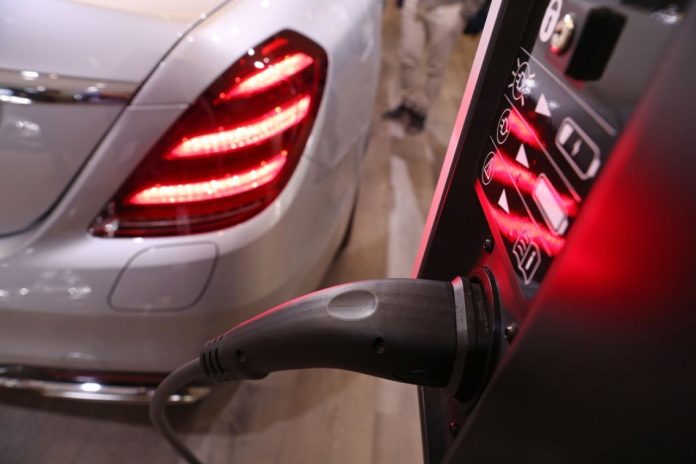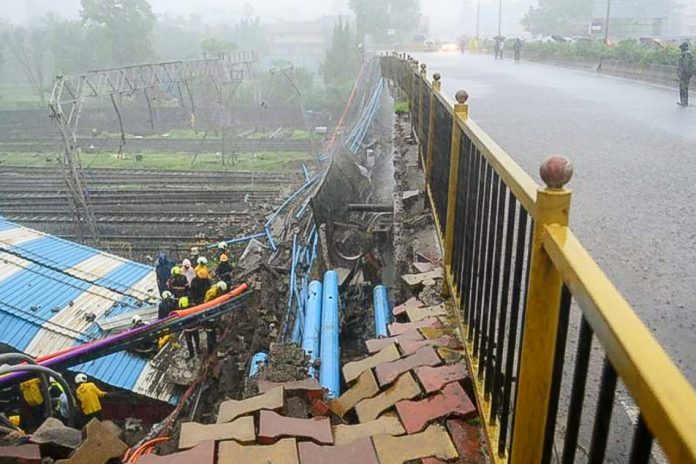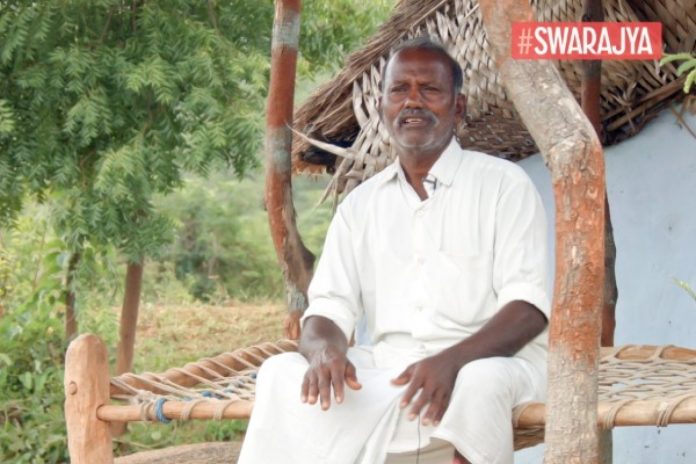Fears Of Lower Compensation
Swarajya travelled to the villages where lands and houses fall under the expressway corridor on reports that the people were opposed to the project and were unwilling to part with their belongings, be it land or house. But during the visit, what we found was that these people are looking for better compensation and are more worried that they might have to settle for a lower payout. Sentimental attachment and value definitely matter to these people, but some of them are able to see reason with the government’s objective.
“I would be happy if the (state) government can give a job to either my elder son who has done M A and B Ed or my younger son who is a graduate,” Kuppusamy of Palayam village says. His elder son, who lives in a nearby village with his wife and two kids since it has better facilities, has been trying for a teacher’s job through the common test that the government holds periodically without much luck. The younger one does temporary jobs at Harur.
Kuppusamy cultivates paddy, ragi, sorghum, and tapioca on his farm depending on water availability. “Our lands are rain-fed. Rains have played truant last five years that we have grown paddy only once. Otherwise, we have gone in for hard crops like ragi that don’t need much water,” he says, adding tapioca is the best since even a little rainfall will help the plant survive for two years once it gains roots.
Kuppusamy himself does farm labour in nearby Coimbatore district, so much so that he had to miss the public hearing held by the district officials on taking over his land. “I get Rs 400 minimum daily if I work in farms in Coimbatore,” he says.
“The government should consider giving jobs to my grandson,” says Salaithoppu, whose elder grandson living in Chennai is an engineering graduate. His second grandson is in college. The elder son is engaged in poultry meat business. He attended the public hearing at Harur, but says it got disrupted by elements who were unwilling to listen to district officials’ offer for their lands.
Salaithoppu’s younger son is engaged in farm labour like Kuppusamy, while he has married off two daughters with sons-in-law as policeman and teacher.
“I get at least Rs 1,000 a week from the cows I have here,” Salaithoppu says, pointing to a couple of cows grazing nearby.
“We have been depending on farms for our livelihood. I have coconut, mango, guava, lemon, custard apple, and even timber trees on my farm. We have to find an alternative place or even buy lands somewhere. We have enquired on buying lands nearby, but prices have increased by Rs 5 lakh an acre to Rs 12 lakh an acre soon after the government said the Salem-Chennai expressway is coming up this way,” he says.
Land prices have shot up by over 70 per cent in the last three months, raising concerns of those who will be displaced and looking to settle in nearby areas.
Officials have put up posts with stones painted yellow in places where the highway will be built, but no financial aspect of the taking over of the land has been discussed with them yet.
“These farmers will be given a fair compensation over and above the 2013 Right to Fair Compensation and Transparency in Land Acquisition, Rehabilitation and Settlement Act,” says an official engaged by the National Highways Authority of India.
Last week, the Tamil Nadu government told the Madras High Court that it would pay up to four times the value of land to the farmers.
Officials, who did not wish to be identified, said that, for example, if the value of a land is Rs 1 lakh, a farmer whose land will be taken up will be entitled to an additional Rs 1.25 lakh as per the Land Acquisition Act. The farmer will, in addition, get a 100 per cent solatium to this compensation. This means, if a farmer gets Rs 2.25 lakh per hectare for a land of his valued at Rs 1 lakh, he/she will get a solatium of Rs 2.25 lakh. So, the total compensation for a land of Rs 1 lakh value will be Rs 4.50 lakh.
“Besides, each tree of the grower is valued. A coconut tree that is good and yielding will get Rs 50,000. There is a person who stands to lose 900 of his coconut trees and he will get a compensation of Rs 4.5 crore,” says an official, adding mango trees will be valued at Rs 30,000 each depending on their growth. Values have been fixed for other variety of trees, while a compensation of Rs 25,000 will be paid for every cattle shed that will be lost. Again, even wells that will be closed will fetch as much as Rs 3.75 lakh depending on its depth and if a pumpset is attached to it.
Another official, with the National Highways Authority of India (NHAI), pointed out that in 2008 when lands were acquired in Salem for the National Highway to Thiruvannamalai, farmers got poor compensation. “And compensation for this will be paid directly by NHAI. So, farmers will not have to run here and there for their money as it had happened previously,” the official said.
“We hear different statement from different persons. We haven’t heard anything from government officials. The government can counsel or talk to farmers and landowners individually and tell them what compensation they would get,” says Kannan of Achankuttapatty village, adding, “we are happy to give our lands for a national cause.”
“Farmers in these villages are hearing rumours and stories that are not true. They are being scared by rumour mongers and activists like Piyush Manush. They are even being told that they won’t get any compensation for their land. We had to use our personal equation with them and convince them that they will get good compensation. But we haven’t been able to answer how good it will be,” says an official, specially deputed by the state government, to facilitate the project.
For instance, Salaithoppu of Palayam village will get more from his trees than the two acres he is losing. “He will easily get over Rs 30 lakh,” says another official, adding that the beneficiary is yet to be informed of his actual compensation.
But what is agitating the minds of people like Vidyasekar or Kannan is that they are looking for the market value of the land and are not clear what they will be getting. “I have spent many years tending to my plants and as I near the age of 50, I thought of bringing my family and living here. We have teak, coconut, and mango trees. They all have a value that will stand good for years. No official has come forward on what we will be entitled to, despite we having come forward to give our lands. The guideline value, which we hear is used to determine compensation, is far lower than the actual price our lands command,” says Kannan.
The issue with the market value for land is, officials wonder, how it could be determined. “There is no way to determine the market value because each one has his or her own quote. We can always take the sale value of various lands sold in the area and come up with an average rate. Then, these persons will get four times the value which would be equal to or more than the market price. In addition, they get separate compensation for the trees and other belongings,” says a state government official.
The problem with the guideline value is that the Tamil Nadu government reduced it by 33 per cent last year. The value was cut to help push up sagging land sales that fell after the stamp paper duty for registration was raised to 12 per cent of the land sale value from 8 per cent. “Many of these people who now demand market value themselves never paid the due stamp duty. They now fear that they will fall victim to their own practice of paying lower registration fees. Luckily for them, a few have shown higher sale value that can stand them in good stead now,” said the state government official.
“We heard news on television that we will be paid Rs 350 per square feet for our house that will be lost to the highway. That means, I will hardly get Rs 4 lakh for it. But the cost of my house construction is nearly Rs 15 lakh. Even the jewels pledged for the construction have not been redeemed. How can I settle for a lower compensation, especially when we have to go to a new place and start from ground zero?” wonders Vidyasekar.
Government officials say the Tamil Nadu government is striving its best to ensure smooth acquisition of lands with better compensation, resettlement, and rehabilitation.
“Resettlement and rehabilitation are not part of any acquisition for infrastructure. But over here, resettlement and rehabilitation are being made. District collectors in the five districts are going all out to ensure no one who offers his or her land will be affected,” says the government official.
Last week, Chief Minister Edappadi K Palaniswami handed over documents of fresh land allotments to five persons. A few persons in Achankuttapatty village have also received pattas for the new place they will be moving to soon. The officials have sent a list of more persons losing their houses in Achankuttapatty village to the district collector so that they can be allotted lands or houses.
“If any vacant government land is available, we are giving it to these people who are giving their lands. In some cases like Palayam village, the collector has ordered allotment of houses under the “housing for all” scheme. We are even getting them loans to construct new houses under the Prime Minister’s housing scheme,” said the state government official.
During Swarajya’s visit to these villages, people talked more about better compensation and are willing to give their lands and belongings. NHAI and state government officials say that once they discuss the compensation package with the people, they will realise the benefits. “Right now, they are angry because of misgivings like they having to travel over 50km to access even their land that could be across the road. Scare-mongers have even told these villagers that high walls will prevent them access throughout,” says the NHAI official.
The Swarajya team didn’t witness any protest or murmur against the project nor did it come across any written material against it. This was despite Pattali Makkal Katchi youth leader Anbumani Ramadoss holding a public hearing at nearby Ammapettai at the same time on 27 June.
The bottom line, then, is that farmers are ready to give their lands for the project, only that they will have to be taken into confidence on the compensation package that each will be entitled to.








